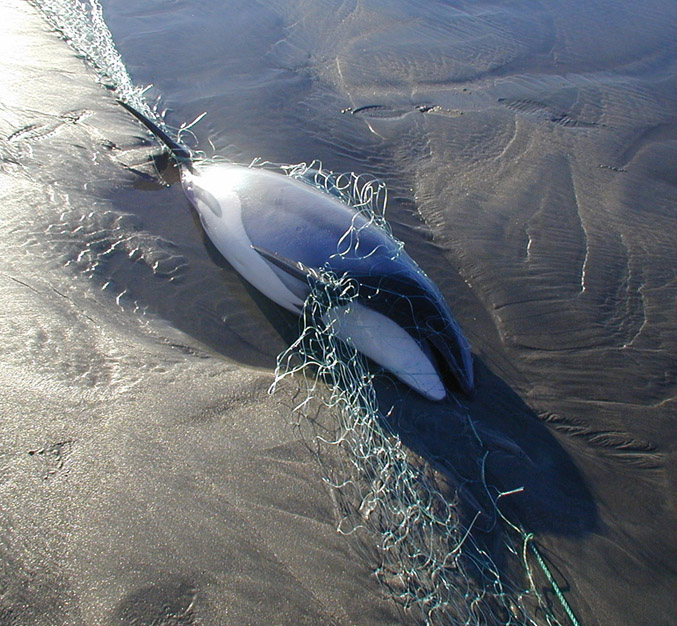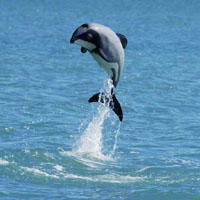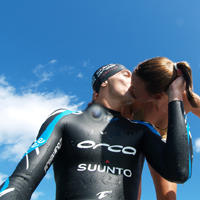New Zealand's Dolphin
Zoe Helene Interviews World Champion Freediver William Trubridge
World Champion Freediver calls Extinction New Zealand’s Native Dolphin “Shameful” and “Shocking” Will Trubridge holds 15 world records in freediving, an extreme sport that requires divers to breath-hold into the abyss. He’s the first human to reach a depth of 100 meters without fins, rope, weight or any other assistance, and he’s won the World Absolute Freediver prize twice. His life is busy with competitions in Europe and his own elite freediving freediving school, Vertical Blue, in Long Island, the Bahamas. Yet he makes time to advocate internationally for New Zealand’s critically endangered Maui’s dolphin because he’s appalled at the circumstances that are causing its imminent yet totally avoidable extinction.
Trubridge grew up in New Zealand, where the powerful fishing industry’s gill net fishing and trawling threaten to kill off the nation’s only indigenous dolphin. With a population that has plummeted from 2,000 in 1970 to 55 today, New Zealand’s Maui’s dolphin is a poster child for what the fishing industry considers “bycatch.” The sea mammals get caught in the fishing nets and drown, and New Zealand’s lax fishing regulations have allowed nearly the entire population to be killed off. But even in the face of local and global citizen outrage, New Zealand refuses to extend protective measures.
Maui’s dolphins are a sub-species of Hector’s dolphins, the smallest and rarest dolphins in the world. “They’re intelligent, friendly and beautiful, and they only live in New Zealand,” Trubridge says. “Maui’s dolphins live in a relatively small territory on the West Coast of the North Island, and they’re almost gone. Under existing laws, the species will be extinct by 2030, and the New Zealand government is apathetic if not downright anti-ecological.”
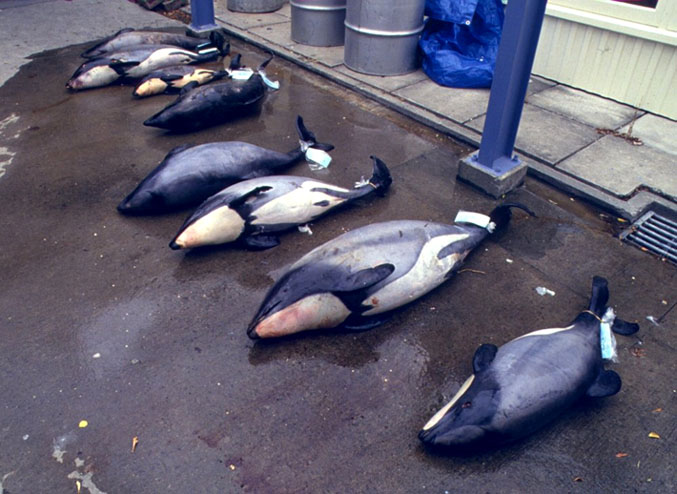 Resources for Helping to Save New Zealand's Native Dolphin ♥ “It’s not a kind of thing where you can keep everyone happy or avoid collateral damage, but the priority has to be saving a species, and scientifically appropriate measures need to be put into place immediately.” - William Trubridge
Resources for Helping to Save New Zealand's Native Dolphin ♥ “It’s not a kind of thing where you can keep everyone happy or avoid collateral damage, but the priority has to be saving a species, and scientifically appropriate measures need to be put into place immediately.” - William Trubridge
SAVING NEW ZEALAND’S DOLPHINS
You’re passionate about helping the Hector and Maui’s dolphins.
They’re classified as “critically endangered,” and they face a real and present danger of being driven extinct. We can't afford to lose a single one.
When did they start keeping track?
1970—and since then the Hector’s dolphin populations have dropped from 30,000 to just over 7,000. That’s more than 75 percent. It’s even worse for Maui’s; in 1970 there were 2,000, and today there are only 55.
And this is mostly because of fishing practices?
Yes. They’re “bycatch,” a euphemism for killed accidentally. They get caught in nets by fishermen who are after something else. Dolphins eat fish, too, so they’re likely to be in the same areas where a fisherman would set or drag a net.
Dolphins breathe oxygen just like we do, so when they get caught in those nets they have about three minutes of terror before they drown. They’re very intelligent, so during that time any other dolphins around would be screaming for help. Sometimes other members of the pod try to help them, and then sometimes they get caught and drown, too. There are shocking photos of multiple dead dolphins caught up in nets that have washed up on shore. There are other photos with dead dolphins lined up one after another.
Most people don’t know much about dolphins, and many people either don’t know or don’t remember that they breathe oxygen just like we do. Do you ever think about a dolphin trapped in a net and how it might experience drowning?
I do, definitely. In spite of how comfortable and at home I am under water, the idea of being trapped in a net or a cave or something like that is still a huge nightmare for me. People who have had near-death experiences, who have drowned and have survived to tell the tale, talk about a sort of euphoria just before they passed out. While that may be the case, that euphoria has got to be preceded by a type of panic that would just be awful, and I don’t think there would be any difference for a dolphin. A dolphin would definitely also experience those sorts of sensations and that sort of panic. It’s a terrible thought to imagine Maui’s and Hector’s dolphins—and other dolphins all over the world—being caught in gill nets and drowning.
And the government knows about this.
The New Zealand government has known that the species is in rapid decline for at least 30 years, yet still they allow both commercial and recreational gill nets and trawlers to be used within the dolphin’s territory.
Is the New Zealand government doing anything to protect them?
There’ve been small gains for their protection, but nothing really significant and nothing that solves the problem. The current biological projection is still extinction under existing laws. The current government is so apathetic about anything ecological. The types of comments they make about this issue or other environmental issues like fracking or drilling for oil in the ocean clearly show how little they care. They certainly are not motivated by the intrinsic good of protecting a species.
Shocking! What motivates the New Zealand government?
Finances. Money. If we can prove that it is actually more profitable financially to protect the Maui’s dolphin than to allow it be rendered extinct for the sake of cheaper fish n’ chips, then maybe the species has a chance.
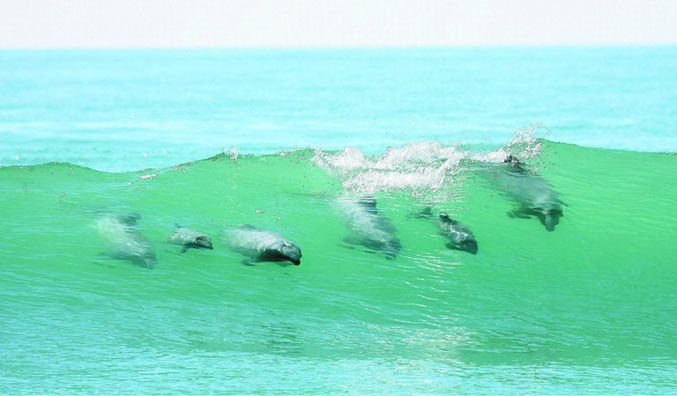 Resources for Helping to Save New Zealand's Native Dolphin ♥ “The current (New Zealand) government is so apathetic about anything ecological. The types of comments they make about this issue or other environmental issues like fracking or drilling for oil in the ocean clearly show how little they care. They certainly are not motivated by the intrinsic good of protecting a species.” - William Trubridge
Resources for Helping to Save New Zealand's Native Dolphin ♥ “The current (New Zealand) government is so apathetic about anything ecological. The types of comments they make about this issue or other environmental issues like fracking or drilling for oil in the ocean clearly show how little they care. They certainly are not motivated by the intrinsic good of protecting a species.” - William Trubridge
100 PERCENT GREENWASHING
Even in the digital age, with the Internet connecting people all over the world, New Zealand is still very isolated. I recently visited New Zealand after many years. I felt betrayed that I had grown up there and hadn’t even heard of either the Maui’s or Hector’s dolphin. It’s almost like the government is suppressing their existence because it doesn’t want to admit to the crisis or do the right thing to protect it.
A lot of what we’re doing is calling them out about that. I watched an interview with Prime Minister John Key by a very prominent British reporter who pretty much called him out the entire interview about the “100 Percent Pure” New Zealand tourism advertising campaign.
You mean the “come to New Zealand where we’re progressively environmental and everything is protected and pristine” green-washing campaign?
Right. And the truth is, New Zealand rivers are contaminated, vast areas are deforested and topsoil is eroded, plus a lot of other environmentally devastating things are taking place. I think what saves New Zealand in terms of environmental impact is that there are so few New Zealanders. New Zealand’s current population is approximately 4.5 million, whereas in Japan—which is about the same size—the population is approximately 127.5 million. If there were as many New Zealanders as there are Japanese, New Zealand would have completely destroyed its entire ecosystem 1Resources for Helping to Save New Zealand's Native Dolphin0 or 20 years ago.
The New Zealand national election is coming up on September 20 (2014), and this is a critical moment for the Maui’s and Hector’s dolphins and New Zealand’s environmental protection overall. Prime Minister John Key of the National Party consistently chooses money over wildlife, and that focus on money has made him blind to the bigger picture of New Zealand’s future. The Hector’s and Maui’s dolphins can’t afford to have him in power again.
Do you think the Green Party has an actual chance?
The Greens won't ever be the party with the biggest percentage, but New Zealand has an mixed-member proportional representative government system, meaning all the parties are represented to the degree that they were voted for, and a Labour-Green alliance could potentially beat National.
You’re not a Kiwi by birth?
I’m not, but I grew up there from a young age and associate with New Zealand as my homeland. I had only a vague idea about New Zealand dolphins until I was planning Project Hector, an attempt at a world record of one hectometer (100 meters) that was also intended to raise awareness about the species’ plight and compel the government to protect them. As a kid I knew all about the different species of fish because we lived in a boat, and I used to do projects on dolphins and whales. I loved them! But I was completely unaware of the New Zealand Hector’s and Maui’s dolphins and their plight.
As the poster child for “bycatch,” the Maui’s dolphin is caught up in an ethical as much as an environmental crisis, then?
Very much so—and it’s a race against time. Unless the New Zealand government bans all use of gill nets and trawling, within the full territory of the species as defined by expert scientists, the Maui’s dolphin will be the first species of marine dolphin to be rendered extinct due to human causes. This would set a tragic and shameful precedent, and New Zealand would go down in history for it.
How do you feel, as a New Zealander and a professional freediver?
I feel a great sense of urgency in the campaign to save the Maui's Dolphin species. Their demise is not a complex problem, and there is scientific unanimity on the cause of the problem, which could be resolved by a simple change in policy—literally a swipe of the pen.
With enough international pressure, I believe the government's hand can be forced, as there is too much at stake with New Zealand's reputation built on its “clean” and “pure” branding. NABU international is doing an incredible job of applying and maintaining this pressure, with hundreds of international publications of its press releases, massive social media efforts, diplomatic negotiations and much more. Momentum is still building as New Zealand's September elections approach, and I believe that with a little more funding NABU could push the issue past its tipping point and make a decisive difference for this iconic species.
New Zealand already ranks high in the extinction conversation. The Moa and Hast Eagle are one of the most infamous examples of “co-extinction” by human cause. Extinction of the Maui’s dolphin would only strengthen New Zealand’s existing reputation, and it isn’t reversible infamy. You would think they’d take this more seriously.
I hope they know the world is watching.
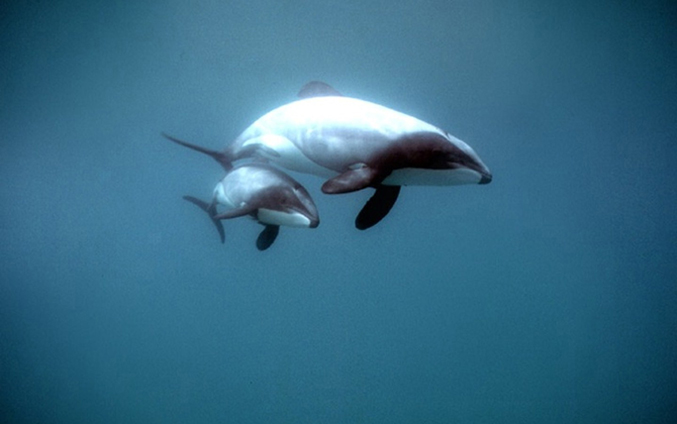 Resources for Helping to Save New Zealand's Native Dolphin ♥ “They’re “bycatch,” a euphemism for killed accidentally. They get caught in nets by fishermen who are after something else. Dolphins eat fish, too, so they’re likely to be in the same areas where a fisherman would set or drag a net.” - William Trubridge
Resources for Helping to Save New Zealand's Native Dolphin ♥ “They’re “bycatch,” a euphemism for killed accidentally. They get caught in nets by fishermen who are after something else. Dolphins eat fish, too, so they’re likely to be in the same areas where a fisherman would set or drag a net.” - William Trubridge
HOW TO HELP THE NEW ZEALAND DOLPHINS
So, what can we do?
The greatest power we have as global consumers is to vote with our voices and our choices. If you were considering visiting New Zealand on holiday, I would encourage you to speak up for the Maui’s dolphin to anyone associated with your travel plans. Let the airlines and hotels and restaurants you visit know you’re aware of the situation and feel strongly about it. I’d even encourage you to consider choosing some other country where the government is actively preserving the environment and wildlife rather than continuing to engage in activities that put them at serious risk. And if you decided not to visit New Zealand for these reasons, then make sure to tell the government and whatever relevant bodies that you’ve made this decision because of their poor practices. Let them know it cost them money, because that seems to be all they’re interested in.
People will come to New Zealand to see the smallest and most rare dolphin in the world!
Right. People will either come to see them or they will not come to New Zealand because we haven’t protected our dolphin.
It costs a lot of money and takes a lot of time to get to New Zealand. If they destroy what they have, why would anyone bother to go there? Who would you ask people to write?
There are various options [see “Resources” below] for sending emails to the New Zealand government, and the more personalized those messages are, the better. That shows that there is diversity from overseas. It’s important to send the ministers strong messages to make sure that they know that you’re not visiting New Zealand or buying New Zealand goods because you want to see the dolphins fully protected.
Other Kiwi brands are doing very well over here in the United States, and I have approached some of these brands to see if they’ll make a statement or take a stand. And also, most of the fish coming over here weren’t caught in the Maui’s dolphin habitat.
The only way to affect change is to target the entire New Zealand seafood industry. I acknowledge that that’s unfair to the ethical fishermen who are doing the right thing ecologically, but those fishermen should already be putting pressure on the ones who are putting the dolphins in danger, and if they aren’t putting pressure, then maybe this could motivate them to do so.
Maui’s dolphins live in a limited geographical region, but you can’t say to someone, “Don’t buy New Zealand taki that’s been fished off the West Coast between such and such and so and so,” which are places they’ve probably never heard of. That’s impossible. So you have to just say, “Do not buy New Zealand seafood.”
Once the government sees some sort of effect of the boycott, hopefully that will motivate them to make the right decision. And yes, some people will be without a job for a while and perhaps some people will even go bankrupt, but that’s sort of petty circumstance when you compare it to the loss of a species, and it’s not the sort of thing we should be considering on the same level. It’s not a kind of thing where you can keep everyone happy or avoid collateral damage, but the priority has to be saving a species, and scientifically appropriate measures need to be put into place immediately.
India is the first country to take a moral stand and say no more captive dolphins.
They actually recognize them as “non-human people.”
Yes! A rapidly growing group of international citizens is passionate about this sort of ethical evolution. But then on the other side of the spectrum, people in Brazil and Peru are catching dolphins and using their bodies as bait for shark fins.
I think that’s mostly ignorance. I would be very surprised if any of them even know that a dolphin is a mammal, let alone an intelligent one. The majority of people just have no idea of the intelligence of the dolphins and how critical they are in the food chain.
You really think it is more ignorance than human greed?
It’s both, for sure. I agree that both are being played out in the international playground. But it isn’t just the seafood industry. Think about the human food chain—the people who are buying these products are definitively turning a blind eye. Business still comes down to supply and demand.
Regardless of the business argument, it is just never OK to kill dolphins, let alone wipe out an entire species—let alone your own indigenous dolphin.
I completely agree.
Is NABU International Foundation your choice of NGO for readers who want to send monetary support?
Yes, it is. NABU International's Maui's Dolphin Defense Fund is easily the organization that has committed the most to this. Barbara Mass, head of International Species Conservation with NABU, has been to all the International Whaling Commission (www.iwc.int) meetings and single-handedly ensured that the text was decisive enough in recommendations to the New Zealand government at the last meeting in South Korea. Dr. Elizabeth “Liz” Slooten (WhaleDolphinTrust.org.nz), a premier Maui’s dolphin scientist, has done all the research in the past decades, and Barbara has spearheaded the campaign to protect them in the last one.
Yes, Barbara Mass was instrumental in helping me understand the core issues and key players when I first learned about the Hector’s and Maui’s dolphins. Like us, she will never give up!
At the end of the day, all the organizations have the right idea and are mostly on the same wavelength, but if someone wanted to donate money to a specific organization to support the New Zealand dolphins, the greatest bang for their buck would come from NABU. All money donated to NABU’s Mau’s Dolphin Go Fund Me (http://www.gofundme.com/Mauis-Dolphin-LDF) campaign goes to support the dolphins.
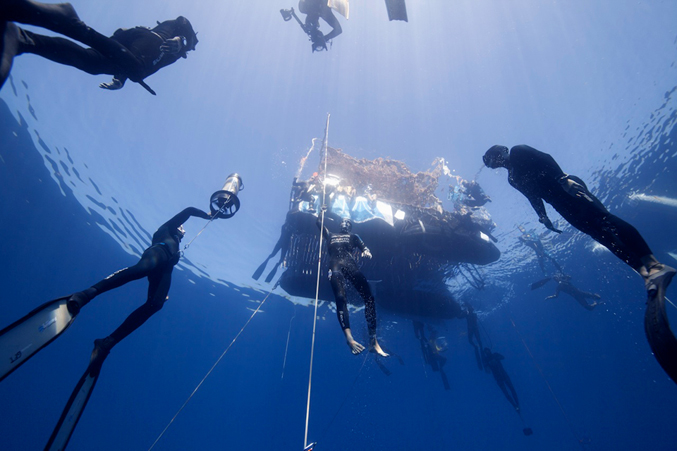 Vertical Blue ♥ “I think freediving should be part of the Olympics because it is the only real expression of what we’re capable of doing under the water in terms of human aquatic potential— speed, height, endurance, strength—and that’s really the spirit of the Olympics. Freediving is the only real athletic discipline underwater. The discipline is referred to as the purest measure of human aquatic potential.” - William Trubridge
Vertical Blue ♥ “I think freediving should be part of the Olympics because it is the only real expression of what we’re capable of doing under the water in terms of human aquatic potential— speed, height, endurance, strength—and that’s really the spirit of the Olympics. Freediving is the only real athletic discipline underwater. The discipline is referred to as the purest measure of human aquatic potential.” - William Trubridge
FREEDIVING: COMPLETE IMMERSION
Let’s talk about freediving. In this age of extreme sports, I imagine it’s pretty popular.
They talk about freediving as being the fastest-growing part of the dive industry. It’s definitely taking off, especially in Europe but also in South America and other parts of the world. In Japan it’s very, very popular. We have ten Japanese athletes coming to Vertical Blue in November.
What is the draw?
There are so many. It attracts people who just love being underwater and the experience of detachment that it gives you and just the novelty of the experience. In any other sport you’re using the boundaries between water and air, whereas freediving is complete immersion. You’re completely liquid.
There’s both a mental and physical challenge, so there’s something holistic about it. It’s not just pure brute force, and it’s not just like a game of chess.
You have to retrieve some sort of marker to prove that you’ve been down to a certain depth, right?
In competition you have a base plate that’s set at the exact depth that you’ve announced the night before. You declare that depth the night before, and you have to retrieve a tag at that depth to prove you’ve reached it. And at the bottom you have to grab a little Velcro tag and attach that to your body to prove that you’ve been at that depth, and then you come back up.
Are more men or women attracted to freediving, or it is about the same?
Both. There are definitely more male athletes, but it’s a sport where females do very well and it does also attract a lot of women.
Are there regions where most of the freediving is happening?
There are centers, yes. In Europe it would be mostly Greece and the South of France. Italy. Russia. Denmark is becoming a focal point. A lot of freedivers from Europe also go to the Red Sea in Sharm el-Sheikh, Egypt.
What about New Zealand and Australia?
Most of the Kiwis and Aussies leave to compete or train because in New Zealand the seas are just too wild and in Australia you have to go too far off the coast and then you’ve got things like jellyfish and sharks.
Can you see this becoming part of the Olympics?
I’d love to see it be part of the Olympics, but I don’t think it will happen soon. The main hurdle is, at least for the depth disciplines, the physical space. For most Olympics locations—even Rio de Janeiro or Tokyo—the sea would be almost impossible to run a freediving competition.
So it’s more about logistics?
Mostly logistics, yes, but that could be solved by throwing a lot of money at it. I’m not sure they’re going to accept a small sport that has a big ticket attached to it.
I think freediving should be part of the Olympics because it is the only real expression of what we’re capable of doing under the water in terms of human aquatic potential— speed, height, endurance, strength—and that’s really the spirit of the Olympics. Freediving is the only real athletic discipline underwater. The discipline is referred to as the purest measure of human aquatic potential.
When I watch videos of your dives online, I know that you came up alive—yet I still hold my breath! How do you keep freediving from being as dangerous as it could be?
The most important thing is to always be operating within your comfort zone, which applies to any extreme sport. If I were a big wave surfer, I wouldn’t go out on the first day of surfing and try to tackle Jaws. I’d start small and build up from maybe a 3-foot to a 4-foot wave, then maybe a 5-foot wave, then a 6-foot wave, and then when I’m ready, maybe a 10-foot wave. I’d gradually take it up, and the whole time I’d only be surfing waves that I’m comfortable with, increasing in slight increments of a little more danger or a little bit more nervousness.
The same applies to freediving. When I first started freediving I was only going 20 or 25 meters down and each day I’d attempt a dive that was 1 or 2 meters deeper than the one before. On those video dives you see online I’m definitely a little bit on edge but not to the point where I’m nervous about risking my life.
How would you describe taking that first breath after you’ve been all the way down and back?
In a good dive, it’s a beautiful experience. In some dives, even though I’m definitely going to the limit of my oxygen stores, I’m not feeling that intense suffocating feeling or the longing urge to breathe—the contractions, that sort of thing—all the way to the end of the dive. I can feel that I’m running out of oxygen, but I don’t feel the anxiety or contractions because of it. That’s a really beautiful sensation to end a dive with. In that case, resurfacing is a sensation of being reborn into the elements.
When you do a big completion dive, do you already know that you can make it to that particular depth?
In most cases—not all, but often—I’ve previously achieved the dive depth during training. That takes a lot of pressure off. The key difference between a training dive and a competition dive is the extra stress and pressure that’s involved with the crew and the cameras and the audience. In other sports that adrenaline rush might give you an edge, but in a freedive the idea is to slow everything down, so adrenaline would be counterproductive. If I can achieve a depth I’m going for in competition during training, then I’m a lot more relaxed and at peace mentally when it comes to the actual D-day.
What is “safetying”?
Safetying means someone dives to meet me at the end of my ascent. Generally, safety freedivers time their own dives so that they arrive at a depth of 20 to 30 meters as the performing freedivers reach that depth on their ascents. The safety freediver swims close by for the rest of the ascent, ready to assist in the event of a blackout or any other problem. The safety freediver also stays close and observes on the surface after the dive has finished as this is the most delicate phases of the dive, when most blackouts occur.
You measure and track everything about your freediving.
I do. I’m a bit of a nerd in that respect. I have spreadsheets and training diaries, and I’m constantly plotting results. Not as much as I used to, however. I used to record everything, including when I was sleeping and my weight and what I was eating and when I ate it, because different dietary and sleeping patterns and so many other things can influence results. I’m a little less meticulous about it now, but I definitely still keep records and plot progress.
Are you ever visited by other marine life when you’re deep down in the water?
During the dive, not really, no. There’s not a lot of marine life at depths like that. Most marine life, especially in the Dean’s Blue Hole (school.verticalblue.net/deans-blue-hole), is closer to the surface. In the open ocean you might have fish that were swimming around at that depth but they probably wouldn’t come close to you.
Plus, you need to be inordinately focused. If you go down and look around and experience everything that’s happening outside of your body, you tend to consume more oxygen, and that directs the energy out of you. Most freedivers tend to close their eyes. I try to look inside myself and forget that I have a body. That seems to help me calm and use less oxygen and is a lot more conducive to the kind of state you need to be in to freedive.
Were you this type of focused, disciplined person before you started freediving?
I can’t really remember. I don’t think that I had that great discipline. I’d get very excited and put all my energy into something I was really passionate about, but I think we’re all like that to a certain extent. Because I realized I had such a great passion for freediving, I knew early on that I was going to have to have a different level of discipline. I realized that I was going to have to put in a tremendous amount of focus, well beyond just the initial surge. I knew there would be times when I would be really into it and enjoying it and during those times I wouldn’t need to worry about discipline. But then there would be times when maybe I was losing focus a little bit or maybe just feeling disillusioned, and in those times I knew I would need to remember my commitment and use that certain level of discipline. So definitely my discipline and focus have grown as I’ve developed as a freediver. I have had to acquire it.
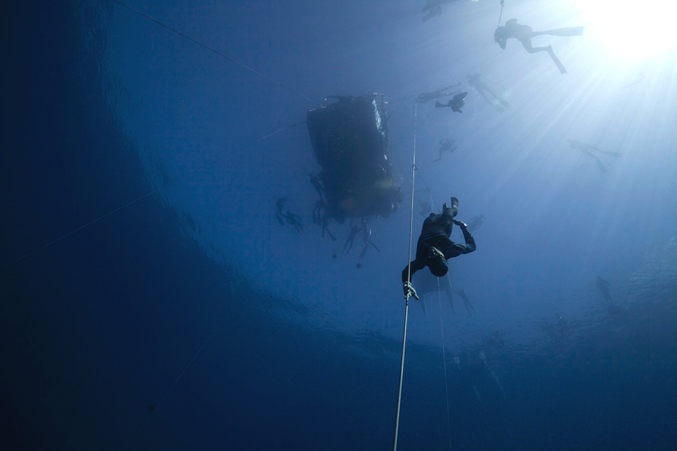 Vertical Blue ♥ “The way I like to describe it is that I feel like a spec of consciousness floating into the deep. I’m definitely still present, but I’m not having as many thoughts or any thoughts at all and I’m not really feeling the experience of having a body at all.” - William Trubridge
Vertical Blue ♥ “The way I like to describe it is that I feel like a spec of consciousness floating into the deep. I’m definitely still present, but I’m not having as many thoughts or any thoughts at all and I’m not really feeling the experience of having a body at all.” - William Trubridge
A SPEC OF CONSCIOUSNESS IN THE DEEP
When you’re diving do you feel that you are you in your body or out of your body? Are you present or traveling somewhere in your mind, where every move and every breath counts? Do you feel that you are having an out-of-body experience?
I’ve done so many dives and so much repetitive training that everything happens instinctively. I’m almost on autopilot during a dive. It’s better to use the subconscious mind to control your motor skills and movements than to be thinking about it.
So I guess the sensation is more like being inside myself. I don’t feel the body as much when I’m in the freefall. When I’m just sort of floating down, there’s no sensation of gravity, so I can’t feel my weight on my heels or any particular point on my body. Also, the senses are all more or less muted. There’s almost no light, sound, smell or taste, and touch is uniform over your body, so there’s very little coming in from the outside and I’m drawn into myself, into my mind in particular.
Also the mind, at least the rational thinking mind, recedes as well. The thoughts slow down as you get into that meditative state, which is also helped by being in the water.
So you put yourself in an altered state?
Yes. The way I like to describe it is that I feel like a spec of consciousness floating into the deep. I’m definitely still present, but I’m not having as many thoughts or any thoughts at all and I’m not really feeling the experience of having a body at all.
What happens in your mind when it is time to go up?
I can’t rely on my mind to give me signal to tell me to turn around. Freedivers use special alarms and signals that tell us to turn around or that we’re getting close.
How do the rational and instinctual minds differ, and how does this relate to freediving?
The Buddhists call the subconscious mind the subtle mind, and the more I freedive and the more I tap into that capacity, the more I experience the incredible power that I have to make calculations or to make decisions much more efficiently than I can with my rational mind, to basically operate my whole organism without thought, more efficiently. Essentially, through repetitive dives and training I’m programming that subconscious mind, giving it auto-suggestions of what I want it to do so that during the attempt it can replay that without having to have the rational mind at all. Logic certainly has its place (for instance, when we don’t know the solution), but when I want to pre-program a dive, then I want to subtract the rational mind from that.
Dancers, musicians and other artists and athletes talk about the “flow,” when they’ve become expert and can just let it all just happen. I’ve experienced that myself in my creative work. Is what you’re describing similar to that?
I think it’s the same thing exactly, yes, except that in freediving we’re lucky enough to be able to get into the flow more quickly. I think that being in the water helps and being at depth where you have the dive effects, which slows down the heart rate and thoughts and everything. Also, the absence of external stimuli, the sensory deprivation, helps. All these things help to boost you into that flow state very quickly, and you can get there within the space of 20 or 30 seconds, even, and just stay there for the rest of the dive.
There is clearly some meditation or yoga present in your freediving technique.
When I first began freediving, in 2003, I’d heard about the importance of yoga in freediving, so right from the beginning I began investigating and experimenting with different yogic exercises—mostly pranayama. Pranayama definitely has benefits. It improves breath holds by increasing tolerance to carbon dioxide and low oxygen. It also helps to create the mental control that’s necessary to stay relaxed within those sensations. It’s one thing to feel that urge to breathe and to be able to carry on and not take a breath, and it’s another thing to feel that urge and be able to stay completely calm and focused and therefore use less oxygen in your body so you can release your mind.
Over the years I’ve also incorporated some of the more physical yoga regime into my training but mostly as a stretching supplement. The physical freedive training I do is so demanding that I’m not able to have a full, compete asana practice as well.
I understand that you and your wife, Brittany Trubridge, teach in other’s training retreats.
We support each other in that way, yes. With Brittany’s retreats, the students are coming for yoga, but on one of the mornings they also can get a taste for freediving, which essentially is a kind of underwater yoga. It’s very basic, for mostly beginners. Then she teaches a basic yoga class in my freediving training retreats.
What have you learned from Brittany?
Britta taught me how to find the “silent witness” during meditation—that part of you that is conscious and observant to every experience and thought but never intrudes or intervenes.
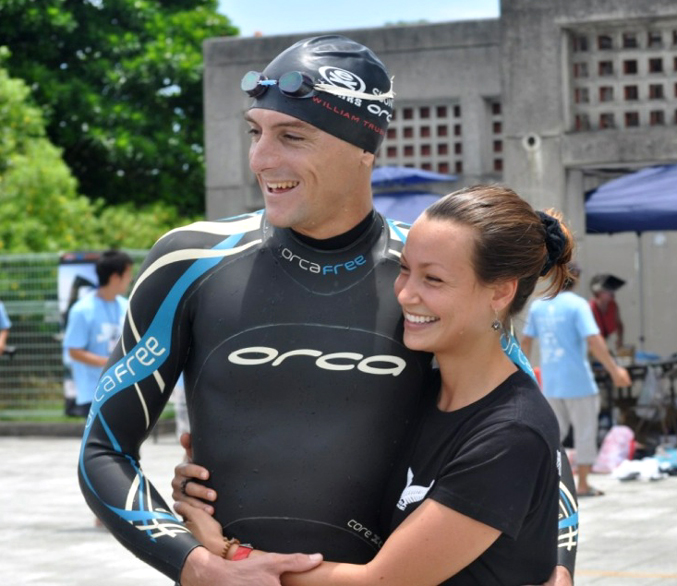 Brittany Trubridge on Ocean Rights and Nature Spirit Yoga ♥ “Britta taught me how to find the “silent witness” during meditation—that part of you that is conscious and observant to every experience and thought but never intrudes or intervenes.” - William Trubridge
Brittany Trubridge on Ocean Rights and Nature Spirit Yoga ♥ “Britta taught me how to find the “silent witness” during meditation—that part of you that is conscious and observant to every experience and thought but never intrudes or intervenes.” - William Trubridge
—END INTERVIEW—
LEARN MORE ABOUT NEW ZEALAND'S NATIVE DOLPHINS
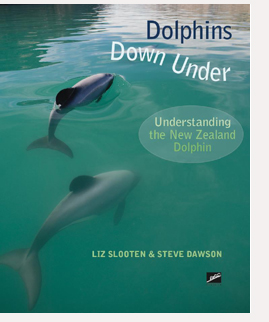 To learn more about the Hector’s and Maui’s Dolphin, check out Dolphins Down Under: Understanding the New Zealand Dolphin (Otago University Press, 2013), co-authored by Dr. Elisabeth “Liz” Slooten and Dr. Steve Dawson, scientific partners who have intensely studied New Zealand’s only endemic dolphins for more than 30 years. To support their work, please visit New Zealand Whale and Dolphin Trust, the leading authority on the Hector's and Maui's Dolphin and the only group actively researching their conservation.
To learn more about the Hector’s and Maui’s Dolphin, check out Dolphins Down Under: Understanding the New Zealand Dolphin (Otago University Press, 2013), co-authored by Dr. Elisabeth “Liz” Slooten and Dr. Steve Dawson, scientific partners who have intensely studied New Zealand’s only endemic dolphins for more than 30 years. To support their work, please visit New Zealand Whale and Dolphin Trust, the leading authority on the Hector's and Maui's Dolphin and the only group actively researching their conservation.
New Zealand is already infamous for wiping out the Moa (Dinornis robustus) and the Haast's Eagle (Harpagornis moorei). The Maui's Dolphin (Cephalorhynchus hectori maui) would be the third human-caused extinction in New Zealand. It would be the first marine dolphin to go extinct at the hands of humans. Even during the great whaling era, humans didn’t quite manage to completely wipe out any whale or dolphin species.
“What is it about the words ‘critically endangered’ that the decision-makers don't understand? This extinction is totally avoidable.” - Dr. Elisabeth “Liz” Slooten
PHOTO CREDITS
Photos of William freediving are by Daan Verhoeven
Photos of Dolphins are by Steve Dawson
Photo of New Zealand Dolphins surfing is by Pierre Gallego
BYLINE
Zoe Helene (www.zoehelene.com) is a media correspondent and advocate for women, wildlife and wilderness. She spent 10 influential years growing up in Aotearoa, the Maori word for New Zealand, which means The Land of the Long White Cloud. Zoe works with leading activists, scientists and environmental organizations across the globe to save species such as the critically endangered Maui's Dolphin and endangered Hector's dolphin from extinction. Hector’s and Maui’s are New Zealand's only native dolphins. Zoe, like the native Maori, considers them taonga, a treasure to protect and cherish.
